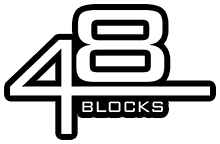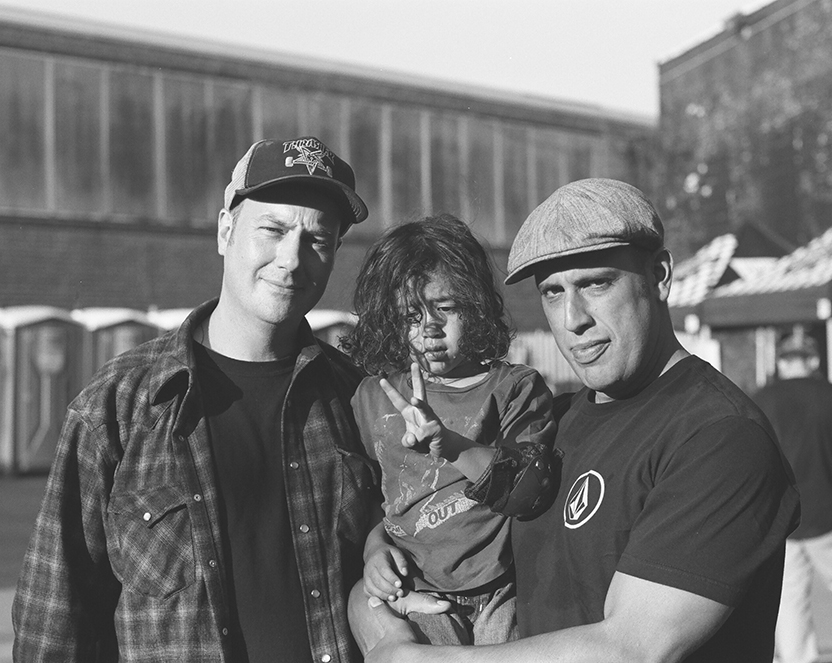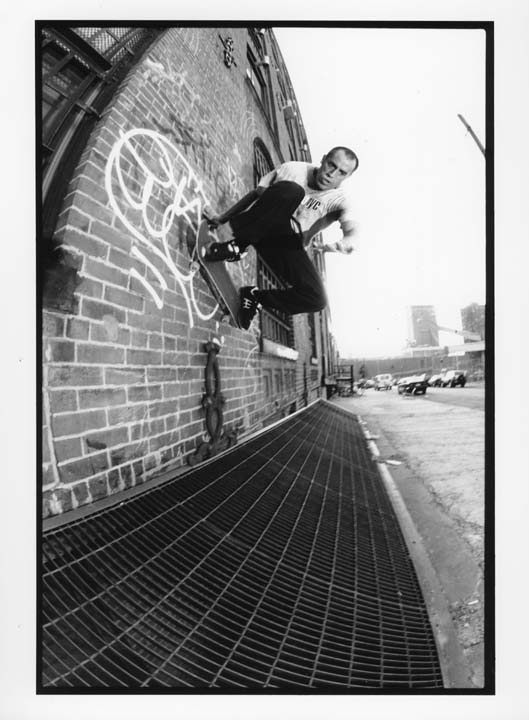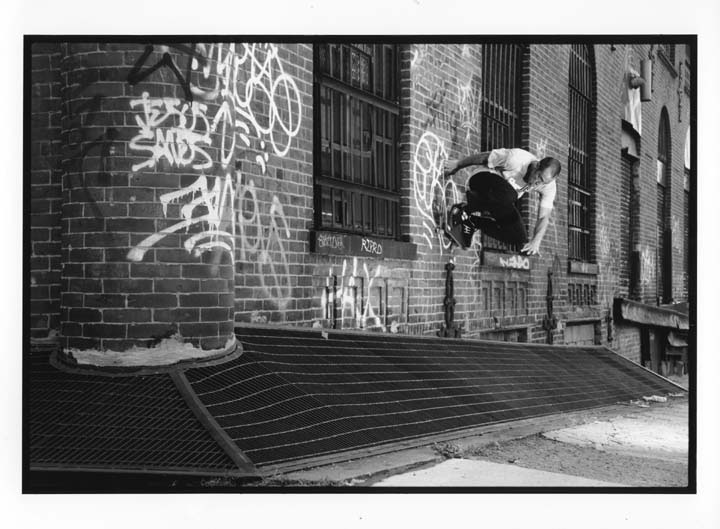Steve Rodriguez is one of the people that truly backs up the love that he professes for skateboarding. He built 5 Boro from the ground up, was an intregal part of saving the Brooklyn Banks, and even works full-time while running his skateboard company. Nothing happens without guys like Steve putting in loads of hard work behind the scenes. He should be an inspiration to everyone.
Interview by Keir Johnson
Keir: Where were you born and what was your life like before skating?
Steve: I was born in 1971 in New Jersey. Life before skateboarding was pretty much the life of any normal kid growing up in New Jersey. I was into BMX before skateboarding. I used to go ride at the BMX tracks and stuff like that. Before that it was normal kid stuff like go to the pool and all that. I was twelve, so I was just doing whatever normal kids were doing.
Keir: How did you first get interested in skating?
Steve: I first found out about skating around ’83. Skateboarding was getting a little bit more popular and a lot of kids started skateboarding. I truly got into it because one of my best friends was into skateboarding and I was into BMXing. I went to his house and he had a quarter pipe. Literally from the first day that I stepped on a skateboard, I was so psyched on it. Just being able to move around and tic tacking. I learned how to tic tac the first day. That’s all I did. I was just tic tacking in circles—going frontside and backside. Going frontside was a little bit harder cause you were falling back every time you turned. I specifically remember that. It’s a super clear memory of this guy Steve Mayor’s driveway learning how to tic tac.
The first skaters that I saw were kids riding around on banana boards. The first skateboard that I ever rode was my sister’s banana board in my basement. I don’t consider that really skating. So that’s not really my first skateboard experience. The first skaters that I saw doing tricks were my friends at school when I was like twelve or thirteen. It was incredible because you’d see someone do something, then you’d step on a skateboard and there was no way that you could possibly do it. It was a real challenge.
Keir: What was your first real set-up?
Steve: My first real set-up was a G&S Billy Ruff with the bubbles on it. I had G&S Yo Yos and I’m pretty sure I was riding Independent Trucks. I don’t even remember the bearings and stuff. I just remember that it was a super wide board and it looked kinda like a bullet. You know, the fish shape.
Keir: What was your first experience skating in New York City?
 Steve: My mom used to manage a store in the City and I’d come in and do a lot of deliveries or go get lunch for the employees. I would skate to what I had to do, like deliver things. Those were my first memories, just skating around Greenwich Village delivering stuff. Back then you couldn’t really ollie up curbs and stuff. So you’d just kind of skate to the sidewalk then put your board on the sidewalk and skate to the next street. Then walk across the street—just exploring the city little by little. Eventually after I went into the city a lot and got a little more into skating, I was actually a skateboarder or what I consider a skateboarder. It turned out that two or three blocks from my mom’s store was the original SoHo Skates—which was the shit back then. That was like the best skate shop. It was independent and underground. It was actually underground. You had to walk down three steps. It’s crazy because there’s an antique store there now. Every time I walk by I think about the original SoHo Skates being there. It was kind of like railroad style. When you walk in and on the left side there were all broken boards on the wall. The right side was all the new boards and there was a counter. It was sick! Such a classic and original skate shop. You really don’t see stuff like that anymore. There are very few shops that are that core. Back then, at basically every skate shop in every scene skaters would meet up then go skate. For me, the shop was SoHo Skates. Some of the notable people that I was stoked on back then were Harry Jumanji—just seeing him do big ollies and kickflips back in the ‘80s. It seemed impossible. Ian From who used to skate for Skull Skates, Chris Riley—he was a guy from Jersey—a lot of the original New York City guys.
Steve: My mom used to manage a store in the City and I’d come in and do a lot of deliveries or go get lunch for the employees. I would skate to what I had to do, like deliver things. Those were my first memories, just skating around Greenwich Village delivering stuff. Back then you couldn’t really ollie up curbs and stuff. So you’d just kind of skate to the sidewalk then put your board on the sidewalk and skate to the next street. Then walk across the street—just exploring the city little by little. Eventually after I went into the city a lot and got a little more into skating, I was actually a skateboarder or what I consider a skateboarder. It turned out that two or three blocks from my mom’s store was the original SoHo Skates—which was the shit back then. That was like the best skate shop. It was independent and underground. It was actually underground. You had to walk down three steps. It’s crazy because there’s an antique store there now. Every time I walk by I think about the original SoHo Skates being there. It was kind of like railroad style. When you walk in and on the left side there were all broken boards on the wall. The right side was all the new boards and there was a counter. It was sick! Such a classic and original skate shop. You really don’t see stuff like that anymore. There are very few shops that are that core. Back then, at basically every skate shop in every scene skaters would meet up then go skate. For me, the shop was SoHo Skates. Some of the notable people that I was stoked on back then were Harry Jumanji—just seeing him do big ollies and kickflips back in the ‘80s. It seemed impossible. Ian From who used to skate for Skull Skates, Chris Riley—he was a guy from Jersey—a lot of the original New York City guys.
Keir: How would you describe the scene at the Banks in the ’90s?
Steve: To me the ’90s were like the second coming of the Brookly Banks. The Banks to me when I think about it first were like the ‘80s, the late ’80s. Then again, in the mid ’90s, that’s when skateboarding got really popular again and that was the place to go. Back then sessions would be intense because people only really skated the one part. When people come to the Banks now they should go see where the historical part is. It’s not what you skate now. It’s the other side. It’s probably 100 feet by 100 feet and the biggest sessions would be there. Maybe like 120 kids at a contest and there would rarely be anybody there that didn’t skate. Now it’s really mainstream. At contests, you have all types of people. But back then, it would only be the skaters. It would also be the skaters that had enough balls to come down here cause it was a little sketchy in the beginning. It was under a bridge. And even though it was right next to a police station, it was in a bad area.
Keir: Which contests at the Banks stood out to you, do you remember the ’93 contest?
Steve: I was at every contest. The contest that really stood out to me was in the ’80s. Somebody got shot or somebody shot at somebody, stuff like that. That to me is more memorable.
Keir: A lot of kids today don’t really know about the original SHUT. What are your memories of that company back then? Did that have any influence on you to start your own company?
Steve: Back in the day, I was psyched on SHUT because it felt like something that you could be a part of. It was East Coast. It was all these guys like Sheffey, Coco Santiago, and Felix. It was people that you could relate to that were part of a company that was from where you were from. So of course everyone was like, “Yeah, this is the shit!” At the time, it was something that was very personal. Everyone was psyched on it. We were like, “Yeah, we have a company now too! We have something on this coast.” SHUT to me was only like a temporary thing because it turned into Zoo York. It lost its luster when everybody quit and rode for other companies and then Zoo York formed. At the time when Zoo York formed, skateboarding was totally different and what Zoo York was about was something that 5Boro was totally not about. That’s why we started 5Boro. We felt like Zoo York was representing a part of skating that we were not psyched on. When I first saw Zoo York, to me it was the same as SHUT cause it was Rodney’s company.
Keir: Talk about the formation of 5Boro. How did you come up with the name and how did you approach starting a company?
Steve: 5Boro was formed in 1996, we’ve been in business for eleven years now. Originally, we had so many names that we wanted to do. That’s probably the hardest thing—coming up with a name. Eventually, we just thought about where we were, where we skated, and what really described where we were. I really don’t even know who came up with the name. It was somebody in the crew or it was myself. Once we decided on that name, everybody was psyched. We were like, “Okay, we’re gonna do it.” As far as the meaning, New York is made up of 5 Boros: Bronx, Brooklyn, Manhattan, Queens, and Staten Island. Those were all the places that we skated. So that was it. As far as financially starting the company, we originally had an investor. But we kind of had a falling out and there was some kind of embezzlement going on. There was all this bullshit. So eventually, we just broke off and did it ourselves.
Keir: Who was the original squad on 5Boro?
Steve: The original squad was Andy Henry, Neil Morgan, Pat Guidotti, Jim Young, JP Lotz, Alex Corporan, Dan Pensyl, Tato Feliciano, Ben Wall, and Jay Hammond. A lot of guys who at the time had the same thoughts and feelings towards the industry and the East Coast and wanted to become a part of something that was original.
Keir: Who was the original artist for 5Boro?
Steve: The original artist for was a guy named Jimmy Gonzalez. He did the original 5Boro logo. He did a lot of the original art in the original line. As the years went on, all my friends would contribute to it.
Keir: What was it like making the jump from skater to company owner?
Steve: There wasn’t too much of a change. I’m still the same guy that goes skating. There’s a lot more responsibility. I have less time to skate. If you ask anybody that knows me, they’ll tell you that I’m the same guy.
Keir: Talk about Aaron Suski. Was 5Boro his first sponsor, what was it like having him on the team?
Steve: Suski was riding for Brooklyn Boards before 5Boro. It’s funny because in his latest interview in Transworld or The Skateboard Mag there’s a little quote that a lot of people were probably wondering about that said, “Zoo York is my third New York company, not my second.” A lot of people probably thought, “What was his first?” It was Brooklyn Boards by Dan Zimmer. He rode for Brooklyn Boards and lived in the City. At the time, 5Boro was starting and he was always skating with us because he had the same passion and mentality about skateboarding. It just kind of worked out eventually. We knew he was going to ride for 5 Boro because he was skating with the whole 5Boro crew anyway.
Brooklyn Boards went under, so it worked out great. I don’t feel like we discovered him. We just helped with the marketing of him. We helped expose him to the right people. He’s an amazing skateboarder and he’s gone as far as he has because of his own talent. Having him on the team was the same as everyone else. Everyone on the team is so integral and everyone brings what they can offer to the company. 5Boro wouldn’t be what it is today without Suski. He contributed so much and helped get so much exposure for 5Boro. Part of his soul will always be in 5Boro. If you really think about it, everyone could change on the team, but Suski’s soul will always be there. Everyone that’s ever been a part of 5Boro is the same way. A little piece of them will always be a part of the company. I’m psyched on how far Suski has gone. I think he’s achieved his goal. He’s a paid skateboarder. He gets paid well. He’s got a lot of sponsors. He travels a lot. He has a kid on the way. He’s doing really good.
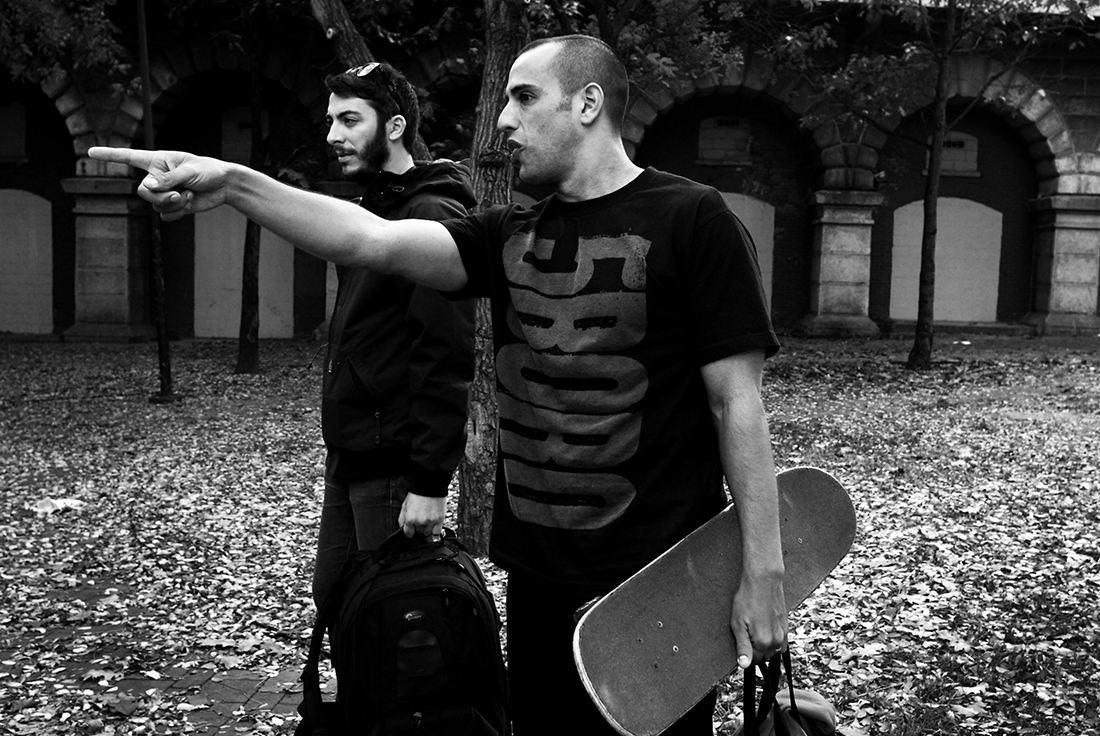
Keir: Everyone credits you with saving the Banks. What role did you play in keeping this spot skateable.
Steve: Saving the Banks is such a long story that it’s almost an interview within itself. Basically, the Banks is just this area under the Brooklyn Bridge that’s really only used by skaters and bikers. There was some kind of mandate in the City that said they had to redo all the parks. They had to redo every park downtown from 14th street and below. And they had to do it over the course of three years. The Banks were one of the parks that they had to redo. They wanted to rip up the whole area. I saw the plans. They wanted to do really weird stuff like put in ping pong tables. Really, no one hangs out down here except for the skaters. So we started going to the City and explaining the significance of the Brooklyn Banks and why it should saved. They basically had to do less to make it better for everybody.
It took some convincing. You had to meet with the Community Boards and you had to meet with the local residents and stuff like that. It was a lot of work. But in the end, it all paid off. The trade off was we gave up the small banks to keep the rest. It’s so sad cause like I said before, that’s all the history over there. I saw it as a size thing. This side is so huge and that side is so small. You give up a little and get a lot. It almost didn’t happen because they had started putting up fences and removing stuff without anyone really knowing. Unless you were familiar with downtown and aware of all this stuff, how would you know?
Once they started putting fences up, right away we were like, “Hey, we gotta find out what’s going on.” Now the Brooklyn Banks is basically a skatepark. It’s a city skatepark. That is the current labeling of this area. You can ride bikes here. You can skate. We’re trying to get the city to allow us to build some more permanent stuff. But again, it’s difficult because of 9/11 laws and things like that. Also, this is a cultural landmark as well. This is the Brooklyn Bridge. It’s very difficult to say, hey we want to build a ramp connected to the Brooklyn Bridge. The goal would be to get this place to be a cultural landmark for skateboarding. If you could do that it would kinda be protected.
After the city designated this as a skateboard area, this place was so dirty that we had an event called Clean Up The Banks. A lot of people would hang out down here and there’s no garbage can or anything. So the city said if you want to keep this area, you gotta keep it clean. Of course, no one would clean it. So 5Boro organized an event where we got a bunch of kids and cleaned up the area as good as possible then threw out a bunch of product. At the first event we probably had about 300 kids. That eventually evolved into the contest / jam thing that we have now called Back To The Banks—which is like a huge thing where 2,000 people show up.
Keir: What memories from all these years of doing 5Boro stand out to you the most?
Steve: My favorite memories are just being with the team—being with the crew. Anywhere you go, to me it’s not like a team. It’s more like a gang, literally. Some of the first trips down to like South Carolina or North Carolina. Like way back in ’96, those were the roots. It was really cool cause it was not only the 5Boro riders, but it was guys that I hung out with and skated with anyway. It wasn’t so business like. Like, “Okay, you’re a rider and this is what you gotta do.” Half of the guys that came on the trips were just friends. It was a very loose atmosphere and to this day it’s still that way. A lot of people that do come on the trips or we meet on the trips are friends that we skate with anyway. It’s a very family oriented thing. We’ve got this storage place where we keep all of the boards that we’ve ever done. And I finally just organize the place. To me, that was one of the greatest things—organizing everything and putting it on a wall and just seeing everything. As you look back, the years just go by in your head. It’s sick! You feel proud of what you did and proud of all the people involved that made it happen.
Keir: Outside of skateboarding what do you do, is 5Boro your full-time job now?
Steve: 5Boro is definitely a full-time job even though I have a full-time freelance job. As far as what I do for fun, my favorite things to do are go skate, hang out with my wife, or just relax and enjoy New York City. I love going on specifically skate trips cause it’s a time where 24 hours of your day is dedicated to skateboarding as opposed to going on a short business trip where you’re chilling at the trade show most of the time and if you’re lucky you get to go skate.
Keir: How did Jimmy McDonald end up on 5Boro? He’s been really blowing up over this past year.
 Steve: Jimmy was someone that sent in a sponsor-me tape. Actually I’m not sure if he sent in a tape or Tombo, the team manager for 5 Boro, got it from somebody. I don’t remember. I think he sent it in. He was sending in tapes for a while. After like his third tape, we were like, “Okay, let’s bring this guy on. Let’s take him to a couple of demos in the city and go on a trip or two.” It was just like anyone else on 5Boro. Get to know the guy, see what he’s doing, see if he gets along with everybody. It either completely works out or it completely does not work out. With Jimmy it worked out. He’s an AMAZING skateboarder. He’s officially on the team now and he kills it. As far as his career skyrocketing, we all know that skateboarding is all about marketing. If you know the right people and you do the right things and pay attention to the right things, things can happen for you. You just need to be intelligent about it. Jimmy McDonald is a super intelligent kid. He understands how things work and he’s dedicated to those that help him. One thing that’s very unique about his skateboarding is that he’s got his own style and he skates his own way. So he’s not like every other kid out there who’s just jumping down shit. I think there’s like two handrail tricks in his last little clip. It’s just very unique. Everyone always refers to Bobby Puleo as doing unique stuff. So I could say that it’s very Bobby Puleo—but in a different way. It’s just his own thing. It’s very Jimmy McDonald.
Steve: Jimmy was someone that sent in a sponsor-me tape. Actually I’m not sure if he sent in a tape or Tombo, the team manager for 5 Boro, got it from somebody. I don’t remember. I think he sent it in. He was sending in tapes for a while. After like his third tape, we were like, “Okay, let’s bring this guy on. Let’s take him to a couple of demos in the city and go on a trip or two.” It was just like anyone else on 5Boro. Get to know the guy, see what he’s doing, see if he gets along with everybody. It either completely works out or it completely does not work out. With Jimmy it worked out. He’s an AMAZING skateboarder. He’s officially on the team now and he kills it. As far as his career skyrocketing, we all know that skateboarding is all about marketing. If you know the right people and you do the right things and pay attention to the right things, things can happen for you. You just need to be intelligent about it. Jimmy McDonald is a super intelligent kid. He understands how things work and he’s dedicated to those that help him. One thing that’s very unique about his skateboarding is that he’s got his own style and he skates his own way. So he’s not like every other kid out there who’s just jumping down shit. I think there’s like two handrail tricks in his last little clip. It’s just very unique. Everyone always refers to Bobby Puleo as doing unique stuff. So I could say that it’s very Bobby Puleo—but in a different way. It’s just his own thing. It’s very Jimmy McDonald.
Keir: What’s the future for 5Boro?
Steve: I just hope it’s as good as the past and we are financially able to continue to support the team guys and continue to give as much as possible back to skateboarding through 5Boro. We want to continue to work with a lot of great companies that do support us. We want to continue those relationships and expand those relationships. We want to not only help skateboarding in general, but help skateboarding in New York City and skateboarding culture in New York City.
